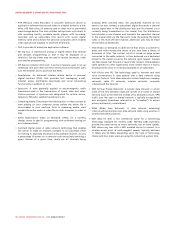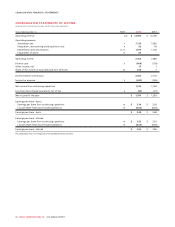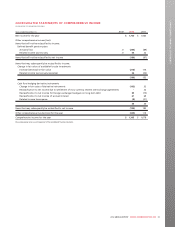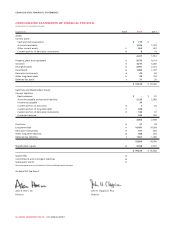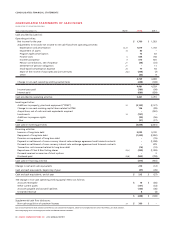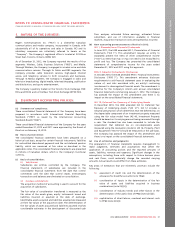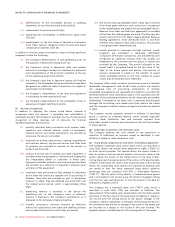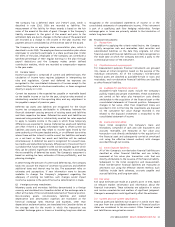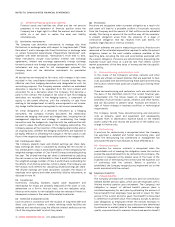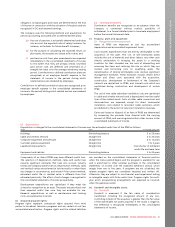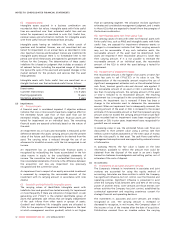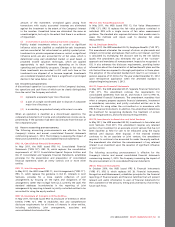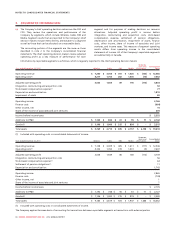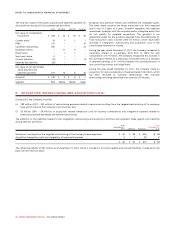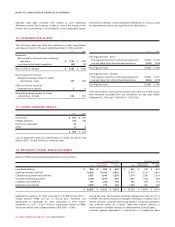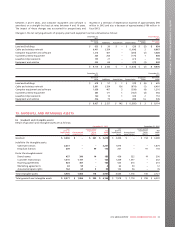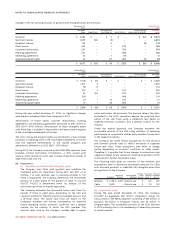Rogers 2012 Annual Report Download - page 94
Download and view the complete annual report
Please find page 94 of the 2012 Rogers annual report below. You can navigate through the pages in the report by either clicking on the pages listed below, or by using the keyword search tool below to find specific information within the annual report.NOTES TO CONSOLIDATED FINANCIAL STATEMENTS
(v) Offsetting financial assets and liabilities:
Financial assets and liabilities are offset and the net amount
presented in the statement of financial position when the
Company has a legal right to offset the amount and intends to
settle on a net basis or realize the asset and liability
simultaneously.
(l) Derivative instruments:
The Company uses derivative instruments to manage risks from
fluctuations in exchange rates with respect to long-term debt (“Debt
Derivatives”) and to manage risks from fluctuations in exchange rates
on certain forecasted expenditures (“Expenditure Derivatives” and,
together with Debt Derivatives, “Derivatives”). From time to time,
these instruments include cross-currency interest rate exchange
agreements, interest rate exchange agreements, foreign exchange
forward contracts and foreign exchange option agreements. All such
instruments are only used for risk management purposes. The
Company does not use derivative instruments for speculative
purposes.
All derivatives are measured at fair value, with changes in fair value
recorded in the consolidated statements of income unless they are
effective cash flow hedging derivatives and designated as such for
accounting purposes. The Company assesses whether an embedded
derivative is required to be separated from the host contract and
accounted for as a derivative when the Company first becomes a
party to the contract. The changes in fair value of cash flow hedging
derivatives are recorded in the hedging reserve, a component of
equity, to the extent effective, until the variability of cash flows
relating to the hedged asset or liability are recognized in net income.
Any hedge ineffectiveness is recognized in net income immediately.
On initial designation of a derivative instrument as a hedging
instrument, the Company formally documents the relationship
between the hedging instrument and hedged item, including the risk
management objectives and strategy in undertaking the hedge
transaction and the hedged risk, together with the methods that will
be used to assess the effectiveness of the hedging relationship. The
Company assesses at the inception of the hedging relationship and on
an ongoing basis, whether the hedging instruments are expected to
be highly effective in offsetting the changes in the fair value or cash
flows of the respective hedged items attributable to the hedged risk.
(m) Earnings per share:
The Company presents basic and diluted earnings per share data.
Basic earnings per share is calculated by dividing the net income or
loss attributable to Class A and B shareholders of the Company by the
weighted average number of Class A and B shares outstanding during
the year. The diluted earnings per share is determined by adjusting
the net income or loss attributable to Class A and B shareholders and
the weighted average number of Class A and B shares outstanding for
the effects of all dilutive potential common shares. The Company uses
the treasury stock method for calculating diluted earnings per share.
The diluted earnings per share calculation considers the impact of
employee stock options and other potentially dilutive instruments, as
disclosed in note 10.
(n) Inventories:
Inventories, including handsets, digital cable equipment and
merchandise for resale, are primarily measured at the lower of cost,
determined on a first-in, first-out basis, and net realizable value.
Previous write downs to net realizable value are reversed if there is a
subsequent increase in the value of the related inventories.
(o) Deferred transaction costs:
Costs incurred in connection with the issuance of long-term debt and
direct costs paid to lenders to obtain revolving credit facilities are
deferred and amortized using the effective interest method over the
life of the long-term debt to which they relate.
(p) Provisions:
Provisions are recognized when a present obligation as a result of a
past event will lead to a probable outflow of economic resources
from the Company and the amount of that outflow can be estimated
reliably. The timing or amount of the outflow may still be uncertain.
A present obligation arises from the presence of a legal or
constructive obligation that has resulted from past events, for
example, legal disputes or onerous contracts.
Significant estimates are used in measuring provisions. Provisions are
measured at the estimated expenditure required to settle the present
obligation, based on the most reliable evidence available at the
reporting date, including the risks and uncertainties associated with
the present obligation. Provisions are determined by discounting the
expected future cash flows at a pre-tax rate that reflects current
market assessments of the time value of money and the risks specific
to the liability.
(i) Decommissioning and restoration costs:
In the course of the Company’s activities, network and other
assets are utilized on leased premises that are expected to have
costs associated with decommissioning these assets and restoring
the location where these assets are situated upon exiting those
premises.
These decommissioning and restoration costs are calculated on
the basis of the identified costs for the current financial year,
extrapolated into the future based on management’s best
estimates of future trends in prices, inflation, and other factors,
and are discounted to present value. Forecasts are revised in
light of future changes in business conditions or technological
requirements.
The Company records these decommissioning and restoration
costs as property, plant and equipment and subsequently
allocates them to depreciation expense based on the related
asset’s useful life, and records the accretion of the liability as a
charge to finance costs.
(ii) Restructuring:
A provision for restructuring is recognized when the Company
has approved a detailed and formal restructuring plan, and
either the restructuring has commenced or management has
announced the plan’s main features to those affected by it.
(iii) Onerous contracts:
A provision for onerous contracts is recognized when the
unavoidable costs of meeting the obligation under the contract
exceed the expected benefits to be derived by the Company. The
provision is measured at the present value of the lower of the
expected cost of terminating the contract and the expected cost
of continuing with the contract. Before a provision is
established, the Company recognizes any impairment loss on the
assets associated with the contract.
(q) Employee benefits:
(i) Pension benefits:
The Company provides both contributory and non-contributory
defined benefit pension plans, which provide employees with a
lifetime monthly pension upon retirement. The Company’s net
obligation in respect of defined benefit pension plans is
calculated separately for each plan by estimating the amount of
future benefits that employees have earned in return for their
service in the current and prior years; that benefit is discounted
to determine its present value. The Company accrues its pension
plan obligations as employees render the services necessary to
earn the pension. The Company uses a discount rate determined
by reference to market yields at the measurement date on high
quality corporate bonds to measure the accrued pension benefit
90 ROGERS COMMUNICATIONS INC. 2012 ANNUAL REPORT


